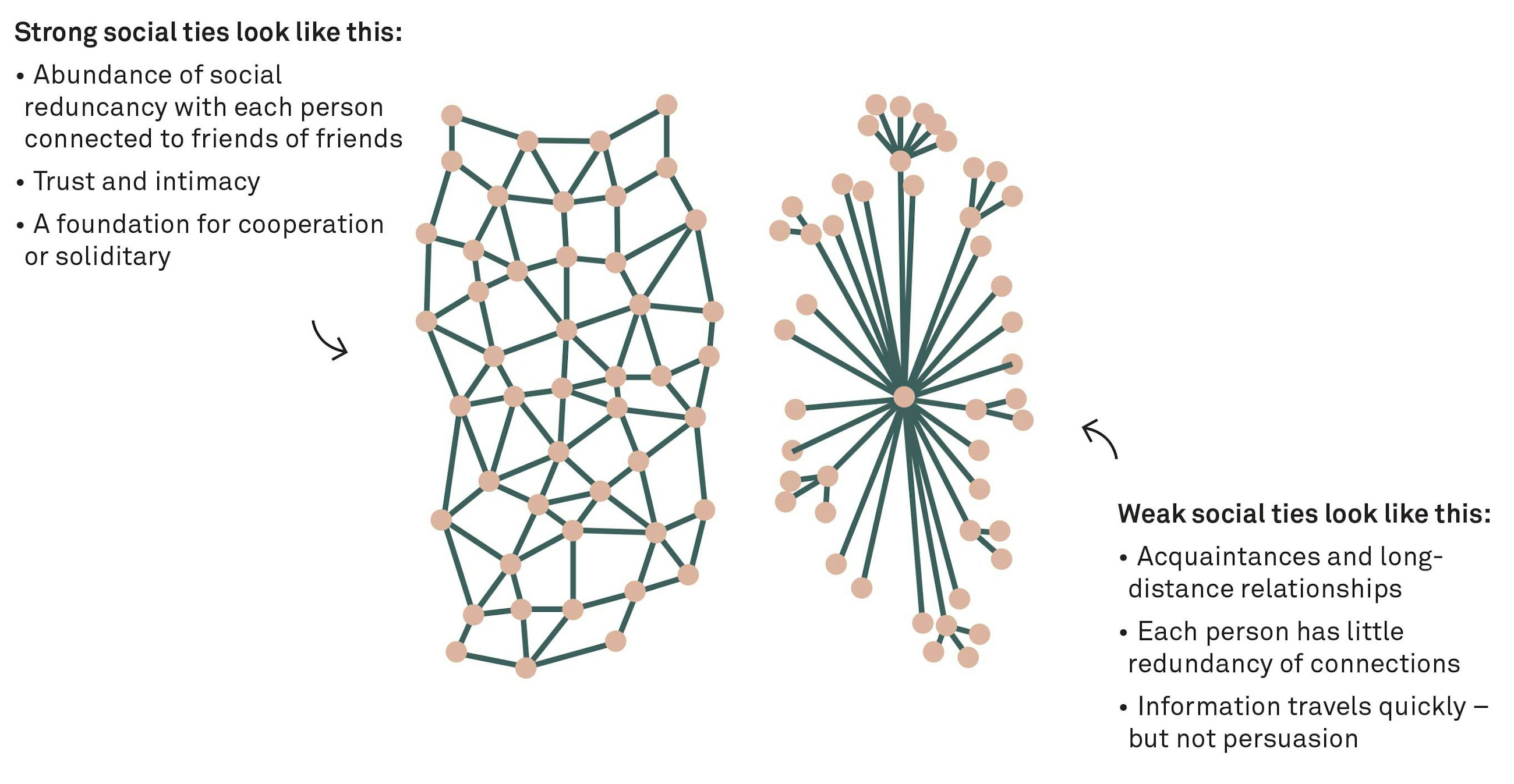What is the most efficient starting point? (Spoiler: It’s not “influencers”)
5 October 2021
A new series of studies on how influence spreads in social networks show that the notion of “the influencer” sitting in the midst of the social web spreading new ideas or behaviour to the network is no longer valid. But if it isn’t the influencer, where do we then find the source of social influence?
COVID-19 has left no one in doubt about how a virus works. An infected person will pass a virus on to one or two or three (or a hundred) others and so, the contagion spreads through the population. Previously, it has seemed intuitive that behavioural change – and organisational change in particular – would spread in a similar way.
Looking at changing behavioural patterns in our organisations, we have therefore identified well-connected employees (i.e. “influencers”) and had them communicate the change initiative to the entire organisation.
The idea behind this approach has been that the more people each individual influencer is connected to, the faster change can be communicated to and adapted by everyone – much like a virus.
However, new insights from social network science show that it’s a poor strategy to rely on “influencers” for changing behaviour in organisations.
Why people think that change is “viral”
Science continuously evolves and improves upon itself. And so does the insights on how we approach change initiatives.
Back in 2008, the change management fan favourite book Viral Change was written. Here, author Leandro Herrero introduces many great ideas for leveraging insights from behavioural and social network science to create actual change.
Approaching change, some of Herrero’s ideas are:
- There is no change unless it is behavioural.
- Change behaviours – get culture. Not the other way around.
These ideas form the basis for the notion that organisational change is all about changing behaviour – or at least it should be – which is now a well-acknowledged “truth” within social network science.
Another of the key principles of Viral Change is that:
“A relatively small number of individuals within any organisation have great power in the creation of change. This power is related to various factors such as high connectivity with others, high trust, or moral, non-hierarchical authority.”
This led to the idea that change spread like viruses and change initiatives would be approached and implemented through central influencers in the social networks. However, a lot has happened within social network science since Viral Change was written in 2008. And one of the most important insights is that change is not “viral”.
Change happens in “fishing nets”, not in “fireworks”
Social network analysists have found that there are many different types of social networks.
Two types of social networks can be simplified as “fishing nets” and “fireworks”:
- Fishing nets consists of tightly connected networks where many people are connected to each other, for instance, project teams that work together every day.
- Fireworks consists of one or a few central nodes that connect to many individual other nodes or node clusters, for instance, a social media influencer or a CEO.
New studies find that easily understandable information tend to spread from the centre of the network and grow outwards. However, looking at social change, it often originates in the periphery and not the core of the network. It tends to emerge in the periphery and grow around the social network only reaching the central people at the end.
This radically changes our classic notion of influence. Consequently, we need to look at what kind of information we want to spread and, most importantly, start looking for important places in the fishing nets to start spreading social change rather than looking for important people like influencers to spread the change in fireworks.
Spreading information is not enough to change people’s behaviour
From new studies on the source of social influence, we see that viral metaphors are useful to describe the way that simple ideas or information, i.e. headline news of a volcanic eruption or news of an organisational scandal, spread in networks.
But there is a big problem with this virus metaphor: to create actual change, you need to do more than spread simple information; you must change people’s behaviours. And those are much harder to influence.
"Dozens of algorithms that are currently used by enterprises seeking to spread new ideas are based on the fallacy that everything spreads virally (…) But this study shows that the ability for information to pass through a social network depends on what type of information it is.” – Damon Centola, Elihu Katz Professor of Communication, Sociology and Engineering
If you want to spread bits of information that are easily digestible, it makes sense to use influencers to spread the information like a virus through the organisation. However, innovative ideas and behaviours do not spread virally because simple exposure is not enough to “infect” you.
If you want to transmit new ways of thinking that may be difficult to understand or challenge an existing set of beliefs, you need to use another approach. When humans consider adopting a new belief or behaviour, we are guided by our own social networks like team members, close colleagues, family members, and not by “influencers”. Therefore, you must seek out hidden locations in the periphery of a network and plant the seed there in order for new beliefs or behaviour to take root and start to grow.
Change happens when people can no longer coordinate
The next bit of “magic” happens when the new idea or complex behaviour has spread from the periphery of a network to other fishing nets in the whole network.
Time and time again, social network scientists have found that once approximately 25% of people in the entire network have adopted a new behaviour, the network reaches what is commonly called “the tipping point”, and the behaviour “spreads” to larger parts of the network.
But why 25%?
The hypothesis is that once 25% of people in the network have adopted a new behaviour, the rest of the people find it difficult to coordinate social behaviour without adopting the new behaviour, for instance using a new leadership model, a new meeting structure, having a 4-day work week etc.
Metaphors matter and your brain runs on metaphors
When you read the word “metaphor” you may think about literary genres like poetry or song lyrics. But research about how the human mind works has shown that your mind runs on metaphors.
A conceptual metaphor, or cognitive metaphor, refers to the understanding of one idea, or conceptual domain, in terms of another. Like when I try to create the metaphor MIND AS A MACHINE in the rubric above by writing that the mind “runs on metaphors”, much like a machine “runs on fuel”. When the mind is conceptualised as an assembly of “mechanical” parts that uses metaphors as “fuel” to make it run, it lets us understand one idea (the human mind) in terms of another idea (a machine).
(If you’re interested in further examples of how the use of metaphors can influence organisational decision making, Gareth Morgan describes eight organisational metaphors in Images of Organization.)
Thinking about change metaphorically as a virus, you will use your knowledge about viruses, how they spread etc. to understand the domain of behavioural change. However, as you have just learnt that’s simply not how complex behavioural change actually happens.
The next step is how
We hope that you have now learnt who to target if you want to change actual behaviour and that the use of metaphors can (mis)guide decision-making. The next step is to learn how you change behaviours.
Reach out if you want to investigate how you can use behavioural design to design change initiatives that are easy and motivating for the people in the fishing nets to use. And if you want to get up to speed on the latest research within social networks, we can highly recommend the new book Change – How to Make Big Things Happen by Damon Centola, a highly accessible book filled with amazing social network research.
References
Centola, D., & Lord, T. (2018). The Truth about Behavioral Change. MIT Sloan Management Review.
Centola, D. (2021). Change: How to make big things happen. Little, Brown Spark.
Erard, M. (2015). See Through Words - The metaphor designer isn’t trying to make something beautiful. She wants to change your view on things. Here’s how. Aeon Magazine, 9 June 2015.
Guilbeault, D., & Centola, D. (2021). Topological measures for identifying and predicting the spread of complex contagions. Nature Communications, 12(1), 1-9.
Lakoff, G., & Johnson, M. (2008). Metaphors We Live By. University of Chicago press.






